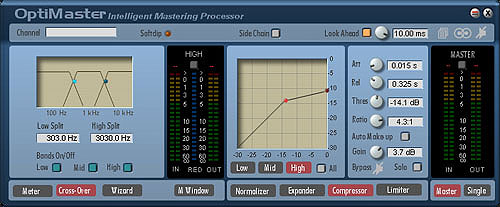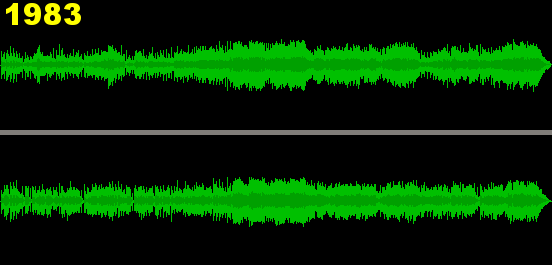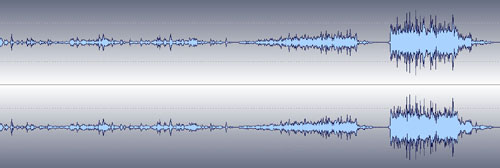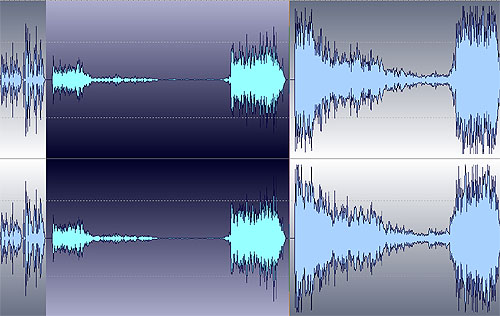Here comes an article not really related to guitar but possibly interesting for everyone who likes to listen to music.
The term “loudness war” is something you might have come across when talking or reading about modern music productions. There is even a Wikipedia article on this matter. I will explain in short what exactly is meant with it, and I will give some listening samples from Knopfler / Dire Straits recordings.
When music is recorded to a digital medium, it is encoded as numerical values. The highest possible value automatically defines an absolute volume limit – also called ceiling. This volume level is called 0 dBFS (decibel full scale). From a technical point it makes sense to record music as loud as possible to the medium, otherwise you had a bit more noise or distortion (due to quantization effects). On the other hand you must not exceed the volume ceiling because this would result in audible distortion (clipping) or clicks.
Now imagine a recording of a live concert, and let’s assume the loudest part of the concert is the final chord of the last song. The “natural approach” would be to adjust the volume so that this highest part reaches exactly 0 dBFS, which means the whole rest of the concert would be at some lower volume. This approach is indeed applied (at least approximately) to some recordings of classical music.
In the music industry however, a central concern is – as everywhere else – competition. Of course everyone who performs music wants to sound good, and if possible to sound better than competitors. For some reasons we tend to think something sounds better than someting else when it is louder, so if you compare two pieces of music, and the first is recorded slightly louder than the second, it seems to sound richer, deeper, more brilliant at the treble end, fuller in the bass – simply better in comparision. Or imagine two guitar pick-ups, one is just a bit louder than the other – most people would indeed say it sounds better.
In any ‘competetive situation’ – e.g. different songs are played by a radio station, or in a disco club – it might be better to be louder than others. This comes to an extreme in advertising , music and voice should be as loud as possible.
This consideration leads to the next logical conclusion: why not simply increase the volume of the live concert of our example, and reduce the volume of just that loudest part at the end a bit so that it does not distort? You will get a higher average volume, and compared with the original version your recording will seem to sound better.
What already becomes clear here is that a further increase of volume is only possible if loud parts are reduced in volume, in other words, you decrease dynamics (which is nothing but the technical term for the volume span from the lowest to the loudest parts of your music). As a rule:
louder = less dynamics

This image shows two similar wave forms: In the left picture, the peak reaches the ceiling (red line) and thus prevents further volume increase. In the right picture the same wave form is compressed, the height of the peak (and thus the dynamic range) is reduced. Next the volume is increased so that the peak reaches the ceiling again. Note how the average volume (blue line) is increased, this wave form sounds louder.
When you look at a piece of music in a wave editor, you will see your music as a landscape of volume peaks – the louder something is, the higher these peaks. Here the term ‘ceiling’ becomes clear: a peak can only reach such a height which is up to the ceiling, more is not possible. If you want to increase the level of the part containing the peak, you must decrease the height of the peak before. This is an artificial change of your music, a reduction of dynamics.
The volume reduction can be achieved on different ways, e.g. you can tell your software to decrease the local volume within a special area around your loudest peak. A more practical way is the use of a device called compressor (or limiter, which is not the same but works similar). This is why the reduction of dynamics is also called compression. (Note that this has nothing to do with “data reduction algorithms” which reduce quality to get smaller file size, something the mp3 algorithm does.)
Normally all commercial music is compressed – not only these days but also some decades ago. It is important to understand that compression is not really bad, it has some important advantages. Besides the possible volume increase, compression makes sure that you don’t get disturbing volume changes. Imagine yourself at home, conversing with some guests, and you have some music running in the background. You want your music to stay more or less at the same level, the level you have adjusted your stereo to. If your music was played by a good band, it might have too much dynamics for this particular situation. Loud passages would disturb your conversation, low passages would be too low. Or imagine yourself driving in your car, the engine creates a certain background noise. Without compression, low passages will be lost behind that noise, or if you increase volume, loud passage would be too loud. So ..
… dynamic compression is not bad itself, there are good reasons for it.
At a live concert the situation is different. You probably don’t want to chat a lot with other concert visitors, instead you will pay full attention to the musical performance. Here it makes sense to have the complete dynamic range the band is able to produce. Loud passages will rock, low passages add contrast. When you are at home and really want to listen to music intensively, a dynamic, uncompressed recording will leave a much stronger impression than a flat, heavily compressed one. A last technical reason for compression is that compressed music requires only a fraction of electric power. Small devices like mp3-players that don’t have a built-in powerful amplifier might distort when you try to play uncompressed music at a certain volume level.

Digital software mastering tool (compression and more, the Optimaster for the Creamware Scope system I use)
The loudness war
Digital compressors react much faster than analog ones. When digital compressors became availabe, it was possible to compress music much more without getting strange sounding artefacts (like pumping, flat sound). No wonder that soon music was more compressed and the overall volume was increased. Suddenly everybody wanted to be louder than the others, it was most important to have the ‘hottest’ mix. As a result of this heavy compression, all parts of the song have almost the same volume, the intro with only a few instruments is as loud as the final guitar solo at the end. And all songs on your CD have the same (=the highest possible) volume, suddenly ballads are as loud as powerful rock songs. Needless to say that many nuances of music are lost, also heavily compressed music is more exhausting to listen to over time.
Note that different radio stations are also in a ‘loudness war’ – they have to compete and want to be louder than other stations. They use their own compressors to even further increase the volume of any music they play, as a result music looses more and more of its full potential.

This image shows the volume of different remastered version of the Beatles’ ‘Something’. Note that short volume peaks that make further volume increase impossibly possibly cannot be seen at this zoom stage. Also not that in the last stage (2000) almost all parts of the song have the same volume.
The way out
The only way out is to stop this war, to leave more natural dynamics, which means to leave the music at a lower volume. This is no problem for anyone who really wants to listen to this music, he can adjust the volume at his stereo exactly at the level he wants it to be – it is only a kind of problem in the ‘competition situation’. Responsible artists don’t care about this and release their music as it sounds best – however, they still have to find a compromise for the different listen situations described before.
Some examples
* Do you remember the remastered versions of all Dire Straits CDs that came out a few years ago? Besides a bit of different different EQ’ing in some cases, the main difference was the higher volume, due to more compression. But they still sound alright because there is no overuse of compression.
* The Communique CD is more compressed than the first album (because it was intended to have an impact on American radio), the drums and bass sound rather flat for this reason.
*The Passalong / Crowfly concert recordings of Mark Knopfler’s 2005 tour were heavily compressed which is the reason I don’t really like them.
*There is a bootleg called ‘On every Planet’ from the last Dire Straits tour in 1992. It seems it was directly recorded from the mixing desk to a DAT tape, and then written to CD (only change was a sample rate conversion from 48 kHz to 44.1 kHz). The volume is lower than a commercial live CD, but if you adjust the volume accordingly, it has an astonishing dynamic range (just listen to the outro of On Every Street or Private Investigations).

This picture shows On Every Street from the uncompressed On Every Planet bootleg, note the volume differences, especially between the parts before and after the break (guitar only, at ca. 80% of the song)

And here the same song from the official (and thus compressed) On the Night CD, note that all parts have almost the same volume.
* The concerts broadcasted by Germany’s NDR3 station are heavily compressed and sound flat, the ones from WDR2 are alright, so are normally the ones from BBC.
You can listen to the following sound file to hear some of these examples. Listen to it as it is and note the volume differences. Then listen to it again, and always adjust your volume level to equalize the differences. Note the resulting difference in dynamics and feel.
Sound clip:
a) original recording of Sultans of Swing
b) remastered version , note the higher volume
c) On Every Street from the uncompressed On Every Planet bootleg (highlighted part in the picture below) , note the drastic volume changes
d) On Every Street from the compressed On The Night CD. Note the constant volume before and after the break due to compression, even that low guitar break is much louder, generally there are only small volume differences

Picture of the sound clip (highlighted part is c)
If you are interested in more technical details, refer to the Wikipedia article on the loudness war: For the German readers who want to learn more about technical aspects of music and recording, my book Das eigene Musikstudio might be helpful which you can buy directly at Amazon following the link below (if you ever want to buy it, please use this direct link since I will get a small commission in this case only).
More info on this book here.

15 thoughts on “Loudness War – Louder is better? Why CDs are reduced in dynamics”
Hi Ingo,
Thanks very much for these highly interesting articles. I very much enjoy reading every single entry, especially those on mk related guitar techniques (+video).
May you long continue to produce and share your views and lessons on these subjects.
A big hat off to you!
Kind regards,
Marco
I really appreciate what you write here, very fresh and smart. One thing though, I’m running Firefox on Linux and some of your layout pieces are a little broken. I know it’s not a common setup, but it’s still something to to keep in mind. Just giving you a heads up.
Ingo, terrific article. Do you think it’s with hunting down an old communique disc?
I would definitely keep those un-remastered CDs (although Communique was heavily compressed on the original version as well)
Ingo, do you mean that those un-remastered CDs have more dynamics than the remastered ones ?
I have the remastered ones, and I thought that the sound was more clean, more “pure”, less noisy.
Now, I’m a bit confused by what you say. Were those old CDs not as bad as it’s common said ?
Theoretically the un-remastered CDs have in fact more dynamics, that is why their volume is lower (more dynamics = lower overall volume). The heavy compression on Communique is on both however 🙁
On the communique vinyl I have,I can also hear sweeter guitar tone with more harmonic overtones. Especially on once upon a time in the west. I like it very much, only with the wdytyg I’m dissapointed because the nice guitar’s volume is too low compare to the other instruments. On the cd they fix that – much louder.
The CD and the remastered CD should still be the same mix as the original vinyl, they were only mastered differently but the mix (and thus the individual instruments volumes) was the same.
I have all three version, too, and don’t think that the guitar volume on WDYTYG (or anything else) was different.
It might however be that if you e.g. reduce high or low frequencies in the mastering process, some cymbals /hihats or the bass seems lower in volume, and thus the guitars or vocals appear a bit louder.
Really? All the songs on my vinyl have the same balance as the cd you’re Ingo but , only wdytyg has the redused in volume lead guitar. I don’t know..
It’s common known that vynils had more dynamics than CDs.
in the late 80ies, when the majors converted all old stuff from 60ies and 70ies, they used the gear from that time, i.e.converters from late 80ies.
A very well known example is the Beatles catalog, which had disapointed many fans, due to a poor sound quality (e.g. magical mystery tour).
In mid 90ies, most of “old” artists had their catalog being remastered (Clapton, Hendrix, Who, Yes, Genesis, Doors, Stones…and of course Dire Straits) I guess they used a better gear, i.e. better converters, and I had always thought that these remastered CDs were more “loyal” to the vinyls, i.e. with a sound closer to the orginal than the 80ies ones.
Indeed, most of Beatles fans agree to say that the remastered albums (from last year or so) are far better than the ones from the 80ies, (even if there’s a lot of debate between mono-mix fans and stereo-mix fans)
So I’m a bit surprised to learn that firts CD had more dynamics than remastered ones. I thought that it was otherwise : in the 80ies, the gear was not able to restituate all the dynamics of the vynils, but with technic progress, I thought that actual
converters (I don’t know if it’s the right english word, but you know what I mean) were more “loyal” to the original sound and could get a better result, closer to the original master tape.
About Communique, I had always found it indeed sweeter, smoother than album one, and that’s why I’ve always preferred it. 🙂
I remember Ingo saying on Mknews some years ago that “sound on album one is clear like water”
Indeed, exactly, but I find that Mark’s guitar sound is “too much” clear on e.g. six blade knife (I prefer a crunchy tone like ine live at the BBC), and I like his tone on Angel of Mercy, SHS, or Lady Writer, more than on Sultans (I prefer his tone on Chorus 78).
Maybe I confuse a little bit between guitar sound and album general sound, but I remember that it was my first impression when I discovered these 2 firsts albums : a little more “gain”, more “crunchy” on Communique, and that was what I liked !
First, vinyl has much less dynamics than CDs (I think just about 50 dB compared to often much more than 80db with digital media). Secondly, it is important to understand what dynamics means in this context: it is simply the difference between the lowest and the loudest signal you can record (without low signals being lost behind noise and loud signals exceeding the 0dB threshold and thus causing distortion).
However, talking about the possible dynamic range of a medium misses the point here because with pop music normally the dynamic range is **artificially reduced** anyway.
Remastered CDs often don’t have a bigger dynamic range but often a smaller. Modern mastering more and more developped toward making a recording hotter ( = louder) than competitors, which implies a reduced dynamic range (maximum loudness would be to stay just a bit below 0 dB all the time, in other words no dynamics at all !) . If you compare the old Dire Straits CDs to the remastered ones, you will notice that the new ones are louder.
Digital mastering units allow you to compress peaks much more efficient than those old analog compressors which always have an attack time > 0 ms (the time a compressor needs to react to a peak), so they are simply faster, and they produce less audible artefacts.
You are right to say that the converter quality of modern equipment is better than converters from the mid 80ies. But I don’t think the aim was to reproduce the analog master tape as faithfully as possible, but instead to process it to make it sound more modern. They also reduced some treble on the remastered first CD which was said to be very trebly (if this is bad or not is just a matter of taste).
Strange that you say Communique sounds crunchier to you, I always have the impression that there is more (subtle) distortion on album one (e.g. Down to the Waterline, Lions, Southbound lead,..) than on Communique. Especially Once Upon a time, News, WDYTYG, Single Handed Sailor sound totally clean to me.
OK, seems I was wrong, again 🙂
I had heard that records on vinyls had more dynamics than on CD, but in fact I guess it was been talking about music style : “old” music in the vinyl age was more “dynamic” (classical, jazz, …) than music in the CD age (mostly due to FM radio diffusion).
So apologize for giving wrong infos 🙂
However, many people continue to claim the “best sound quality” of many vinyls over many CDs
About the aim to reproduce the analog master tape as faithfully as possible, the marketing communication with « remastered » catalog is often based on « you will finally hear the Beatles/Stones/Doors as they really sounded at the time » or such messages.
I’ve always thought that remastering with better converters was to approach more the « original » sound, by amending it the least possible, adding minimal audio artifacts.
But maybe I’m wrong and you’re right. But, in my mind « make it sound more modern » would have been remixed them, and not only remaster them.
About the « crunchier sound » on Communique :
I have listen it again followed by album one yesterday, and indeed, your are right, again 🙂
I must add some precisions here to explain why I have this impression since many years (even if it’s not the real topic of this article :)) :
At first, I must admit I haven’t listen to orginals albums since a long time (apart for writing the gear pages :)). When I want to listen DS, I listen to bootlegs :). So my « sound memory » of originals studios album is from 20 years or so.
When I discovered DS in 1988 (yes, I was abit late…) it was with first Brothers in arms (especially Walk of life, which I guess was more a big hit than MFN, here in France), and then Alchemy, which I listen to for all the summer. So my first DS sounds were « rock » sounds, « crunchy » « bluesy », with more drive than 78-79 tones.
At the end of august, I purchased album one and Communique. At first listen, I found them less exciting than rocking Alchemy. Don’t blame me, I’ve discovered their subtles qualities shortly after… 🙂
And then, my first impression was that songs like Lady writer, Angel of Mercy (I love this song :)), SHS, were more « rockin’ », more « agressive » than album one. But, yes, it can also been due to David’s Rhythm part on lady Writer, or FS-1 on SHS.
The intro on News doesn’t sound so « clear » to me, well I mean less clear than e.g. In the gallery, but indeed, it’s not crunchier, it’s just a « rounder » sound (I don’t know if it’s the word, but thta’s what we say in french).
I totally agree about Lions Southbound (that’s why I didn’t quote it :)), for Waterline and Southbound I must admit that I didn’t pay attention to it for years, but after reading you, I herad it yesterday ! Music can be re-discovered all the time !
For Sultans and Six blade knife, I prefer his live tone at the same time (Sultans-Chorus was the first boot I heard, so I kept this « sound memory »)
Then, after thinking, I realise that Communique has sounded « crunchier » to me, maybe due to the general compression and a more « rounder » sound, maybe also due to Mark’s playing which I find a little more « driving », maybe due to other parts (David’s rhythm on Lady writer and WDYTYG), and maybe because when I’m thinking about Communique, the first tune that came to my mind is Angel of mercy with has obviously the crunchiest lead tone in a studio song from the 78-79 period ! 🙂
Sorry for being long, and maybe doesn’t it interest many people, but I can’t stop me writing about that ! 🙂
I gave a talk on the loudness war at the recent Audio Engineering Society convention. The presentation looks at the loudness war in terms of game theory and gives evidence questioning the idea that louder recordings sell better:
http://www.sfxmachine.com/docs/loudnesswar/